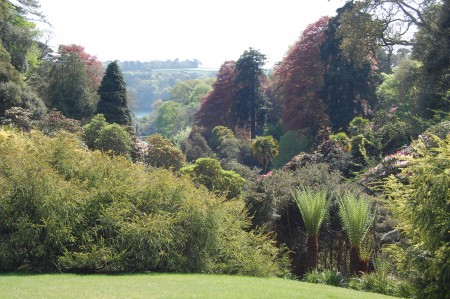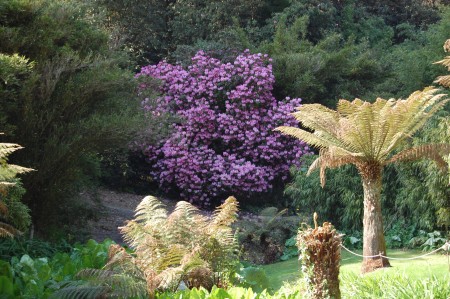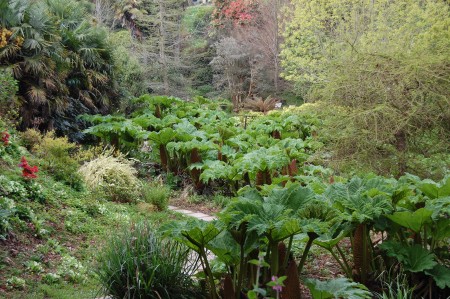Vast rhododendrons, vaster than you ever imagined you’d see, magnolias with their impossibly large flowers on as yet leafless branches, camellias forming virtual forests, Gunnera manicata spreading like an ambitious triffid along a valley floor, sheets of bluebells and other wildflowers, bamboos with stems as thick as drainpipe, cordylines spiking the sky, banks of azaleas beckoning with that scent you could almost drink, and oddities, things you have never seen before and send you scurrying into the leafage to try to find a label, and failing that starting off earnest discussions with your gardening companions.
Cornwall. If you are a gardener and you haven’t been there, make sure that one day you do. With beautiful places like the Atlantic Hotel to stay, you’ll find it hard to leave once your stay is over because the place is just so exquisite. Its valley gardens are like no where else (although some Irish and the occasional Welsh gardens come close). If you look at the place on the map you see how isolated this strangely foreign outlier of England is and how far that finger of land points down into the embrace of the Atlantic . It is this ocean which so effectively moderates winter and summer temperatures and is the source of the rain and the wind which often comes so close to ruining many a holiday in what is to many Brits our favourite place to holiday (but no-one holidays anywhere here for the weather). But it never gets really cold, as it is always a mild wind even when it howls down the chimney of the weekend rental cottage and the rain may pound and drive and seek out every little weakness in the new waterproof jacket but it rarely chills. And …. we all know it is the rain which makes all everything grow like it does.
Simply driving to the supermarket through the often seedy suburbs of towns in what is actually one of Britain’s poorest counties reveals a rich garden culture: undistinguished houses shelter behind vast camellias, cordylines and palms abound on even scrappy lawns, osteospermums sprawl daisy blooms on foliage which almost looks like it is melting over the tops of the retaining walls which bound many gardens in this often hilly area. The sea-facing valleys of the southern coast however provide a view into a more opulent world, for this is where from the late 19th century onwards a small, and closely-knit, group of wealthy landowners began to make gardens. Often they chose to support plant hunters, mostly working the botanical riches of the western Himalaya, where India, China and Burma meet. Plants from this area have been joined by others from regions with a roughly similar climate: New Zealand, Chile, southern Japan, or from Mediterranean climates. The result is an extraordinary botanical richness and a highly distinctive and passionate garden culture, set in an area which itself is steeped in a unique history. It is one of the most truly distinct places I know, and more deserving of any of that word so abused by the travel profession – magical.
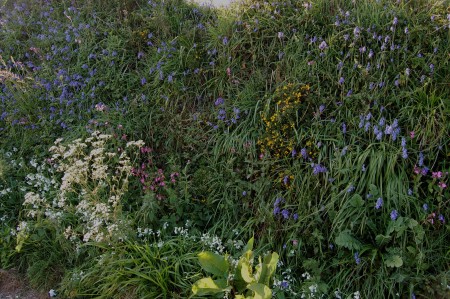
Wildflowers are superb, often growing on steep banks alongside country roads. The blue is english bluebells, Hyacinthus non-scriptus.
Cornish gardens are now a big part of the tourism business here, but they rarely get crowded – apart from the Lost Gardens of Heligan, which has so successful marketed its status as having been supposedly lost, that it is overrun, and the Eden Project, which is not really a garden, but a living museum, and a remarkably successful one. Visits to Cornish gardens are perhaps different in character to most garden visits, because there is not much one an actually emulate – conditions at home for most visitors are so different it is more like visiting a foreign country. They have to be enjoyed for what they are, not for what you might be inspired to make or grow – gardens for the moment.
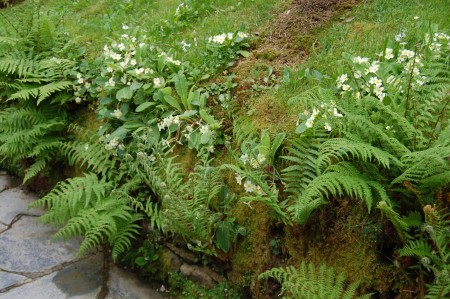
High rainfall ensures that surfaces that would remain bare elsewhere get covered in vegetation - Primula vulgaris and ferns on a stone retaining wall.
This is the first time I have been to Cornwall in years – we used to go often, but we are 2 hours driving time further now. I’m glad in a way we only had a few days, garden visiting interspersed with walking the coastal footpath – where the wildflowers were wonderful, and walking into little villages of stone and narrow streets crammed between the pounding sea and the steep rocky hills. Too many Cornish gardens sate the senses, like a box of chocolates they all begin to taste the same after a while. It is difficult to hold distinctions between them in the memory – all seems a mass of evergreen foliage, vivid colours, thrusting stems, enveloping scents. It does not help that so many start with Tre-, meaning village in Cornish: Trengwainton, Trewidden, Trewithen, Trevarno, Trelissick, Trebah (this last is the best one to go to as it somehow encapsulates the genre so well). There is one further drawback – their season is short, by the time most English gardens are at their peak in June, Cornwall’s are well on the way to the somnolent dark green which is their off-season coat until the first sasanqua camellias and magnolias of February. It is a short sweet dream.
More information on Cornish gardens here.
See my own blog – an entry on how to make wisteria flower rather than pull off your drainpipes will be up later this week.

